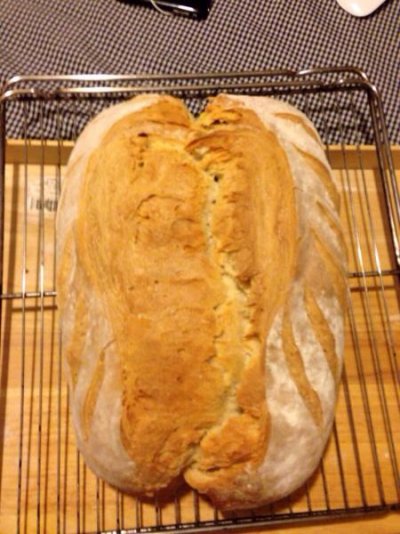Hi! I had a look on the internet: that brand isn't available here in UK. Looks like the protein % is not specified. Although they talk about Proteins: 4g... That's what I see on the screen. There are no other hints. I'm just guessing here, but commonly a bread flour in supermarkets are medium strength flours: 12-12,5%pf proteins which means a 220-240w (another parameter usually only for professional use). If so, I'd suggest this recipe: 1kg of flour, 600gr of water (60% is usually enough), 18gr of fresh yeast (or 6gr dry yeast in pearls), 12gr salt, 14gr honey.
METHOD
Melt or reactive the yeast in some sweater then add it to the test of water. Mix this to the flour. Knead to abstain a quite lumpy dough. Add the honey and knead again. Then spread the dough, sprinkle the salt all ove, roll it up roughly and knead again until the dough looks smooth and elastic (may need 8-10minutes? I just guess since I never take the time for it and I am quite quick!). Put it in a plastic or glass bowl (oil the insides a bit so it want stick) and cover it with a kitchen towel. Let it rest for about 4 hours or until the dough has triplicated the volume. Then take it out press gently to expel the gas and knead it again for a minute or two. Put it back in the bowl and let it rest for another 30-60minutes or until the dough has swelled up again like before. Take it out again and knead it for 30 secs or so. Flatten the dough and fold it in 3 (like puff pastry,ok). Knead gently then flatten it again and react the folding and kneading for another couple of times. Give the dough the shape of a loaf and put it on a baking trey. Cover with a towel. Rest it while u bring the oven to 220°C with a small trey of hot water on the bottom of the oven. When perfectly hot, cut the loaf's skin longwise with a very sharp knife or use scissors ( wet the blades in water before doing it). Immediately put the brad in the oven, lower it to 180°C and let it cook for 80-100minutes. To check if it's ready, hold it whit one hand and knock on its bottom side: it should sound like a drum. Nice a clean sound. If not, means that it needs a bit longer... This is all depending in how u sharpen it and how good your oven is!
Well that's all... I guess... Yes, I think so

let me know!

P.S.
If you use bread machine I really don't know anything about them, sorry! I don't have fun with them! Lol
This is a loaf I kneaded with my 4y/o niece Linda

she had lot of fun!





